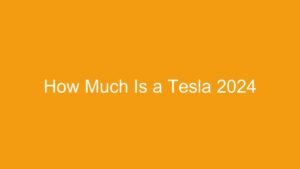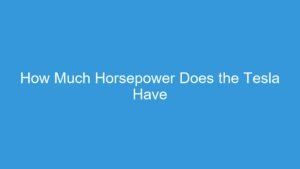
Contents
- How Much Does a Tesla Model 3 Cost? Your Complete Guide to Budgeting!
- 🛒 Recommended Product
- Step 1: Understand the Base Price – Your Starting Point
- Step 2: Navigate Options and Upgrades – Personalize Your Price
- Step 3: Factor in Destination and Documentation Fees – The Essentials
- Step 4: Consider Potential Taxes and Registration – Location Matters
- 🛒 Recommended Product
- Step 5: Explore Incentives and Credits – Potentially Lowering Your Price
- Beyond the Purchase Price: Long-Term Ownership Costs to Consider
- Your Step-by-Step Guide to Calculating Your Model 3’s Price
- Common Mistakes to Avoid When Budgeting for a Model 3
- Tips for Getting the Best Value for Your Tesla Model 3
- Conclusion: Your Tesla Model 3 Awaits!
- 🛒 Recommended Product
- FAQ
How Much Does a Tesla Model 3 Cost? Your Complete Guide to Budgeting!
Considering joining the electric revolution with a Tesla Model 3? You’re not alone! This sleek, high-tech, and increasingly popular EV has captured the imagination of many. But one of the first, and biggest, questions on everyone’s mind is always: “How much does a Tesla Model 3 actually cost?”
The simple answer is, it’s not a single number. The price of a Model 3 can vary quite a bit depending on your choices, location, and available incentives. But don’t worry! This detailed guide will walk you through everything you need to know to get a clear picture of your potential investment, helping you budget accurately and confidently.
Let’s break down the journey to your dream Tesla!
🛒 Recommended Product
Step 1: Understand the Base Price – Your Starting Point
Every Tesla Model 3 begins with a base price, which is determined by its trim level. Think of trim levels as different versions of the car, each offering varying range, performance, and features.
Currently, the main Model 3 trims you’ll encounter are:
- Model 3 Rear-Wheel Drive (RWD): This is typically the most accessible entry point, offering solid range and performance for daily driving.
- Model 3 Long Range All-Wheel Drive (AWD): As the name suggests, this trim provides significantly more range and enhanced traction with all-wheel drive.
- Model 3 Performance All-Wheel Drive (AWD): For those seeking exhilarating acceleration and track-focused capabilities, the Performance trim sits at the top.
Key Tip: The most accurate and up-to-date base prices can always be found directly on the official Tesla website. Prices can fluctuate due to market conditions, so always check the source!
Bold Insight: The starting point for your Tesla Model 3 cost is its base price, which varies significantly by trim level. This is the fundamental decision that impacts everything else.
Once you’ve chosen a base trim, you’ll encounter a menu of exciting options and upgrades that can significantly influence your total purchase price. This is where you truly personalize your Model 3, but each choice comes with a cost.
Common options include:
- Exterior Paint Colors: While a standard color is usually included, premium metallic or multi-coat options come with an additional charge.
- Wheel Choices: Different wheel designs and sizes often carry an extra cost, affecting both aesthetics and sometimes range.
- Interior Color Scheme: Beyond the standard black, an optional white interior package is usually available for an added fee.
- Autopilot and Full Self-Driving (FSD) Capability: This is often the most significant optional add-on. Tesla offers advanced driver-assistance features, with the “Full Self-Driving Capability” package being a substantial upgrade that continuously evolves. It’s a premium feature that adds a considerable amount to the final price.
Bold Insight: Beyond the base trim, your next major influence on the total price will be optional features and upgrades. Choose wisely based on your budget and desired experience.
Step 3: Factor in Destination and Documentation Fees – The Essentials
When purchasing any new vehicle, there are standard fees that are almost universally applied. The Tesla Model 3 is no exception. These are generally non-negotiable and cover the costs of transporting the vehicle and processing paperwork.
- Destination Fee: This covers the cost of shipping the car from the factory to your delivery center. It’s typically a flat fee applied to all vehicles.
- Documentation Fee: Also known as a “doc fee,” this covers the administrative costs associated with processing your purchase and registration paperwork. This fee can vary slightly by state.
Bold Insight: Don’t forget to account for non-negotiable fees like the destination fee and documentation fee. They are part of the final tally.
Step 4: Consider Potential Taxes and Registration – Location Matters
A significant portion of your Tesla Model 3’s final cost will be determined by your location. Sales tax and vehicle registration fees are applied by state and local governments.
🛒 Recommended Product
- Sales Tax: This is usually calculated as a percentage of the car’s purchase price and varies significantly from state to state, and sometimes even by city or county.
- Registration Fees and License Plate Fees: These are annual or biennial fees required to legally operate your vehicle on public roads. They can also vary based on vehicle type, weight, and state.
Bold Insight: A significant, and often overlooked, portion of the final cost will be taxes and registration fees, which are highly dependent on your specific location.
Step 5: Explore Incentives and Credits – Potentially Lowering Your Price
Here’s where things can get exciting! Government incentives and tax credits are designed to encourage EV adoption and can significantly reduce your out-of-pocket expense.
- Federal Tax Credits: The U.S. government offers federal tax credits for eligible clean vehicles. The rules and eligibility (including vehicle manufacturing location, battery components, and buyer income limits) can change, so it’s crucial to check the latest information directly from the IRS or Department of Energy websites.
- State and Local Incentives: Many states, counties, and even utility companies offer additional incentives such as:
- State tax credits or rebates
- HOV lane access
- Reduced registration fees
- Home charger installation rebates
Bold Insight: One of the most exciting ways to potentially reduce your Model 3’s final price is through government incentives and tax credits. Always verify your eligibility and the current availability of these programs.
Beyond the Purchase Price: Long-Term Ownership Costs to Consider
While not part of the initial purchase price, a complete understanding of “how much Tesla Model 3” costs should also include long-term ownership expenses.
- Insurance: EVs, especially performance-oriented ones like the Model 3, can sometimes have higher insurance premiums. Get quotes early!
- Charging Costs: While cheaper than gasoline, you’ll have electricity costs. Consider the expense of a home charging setup (installation, hardware) and public charging fees.
- Maintenance: EVs generally have lower maintenance needs (no oil changes, fewer moving parts), but you’ll still have tire rotations, brake fluid checks, and occasional repairs.
Bold Insight: While not part of the purchase price, it’s wise to consider the long-term ownership costs of your Tesla Model 3, including insurance and charging infrastructure.
Your Step-by-Step Guide to Calculating Your Model 3’s Price
Ready to crunch the numbers? Follow these steps for the most accurate estimate:
- Visit the Official Tesla Website: This is your primary and most reliable source for current pricing.
- Configure Your Desired Model 3: Select your preferred trim (RWD, Long Range, Performance).
- Choose Your Options: Add your preferred paint color, wheels, interior, and decide on Autopilot/FSD capability.
- Review the Estimated Price: The configurator will show you a running total, including the base price, options, and estimated destination/documentation fees.
- Research Local Taxes and Registration: Use online calculators or contact your state’s DMV/tax office to estimate sales tax and registration fees for your specific location.
- Investigate Incentives: Check the IRS website for federal tax credit eligibility and your state/local government websites for additional rebates. Subtract any applicable incentives from your total.
- Get Insurance Quotes: Contact several insurance providers for quotes on the specific Model 3 configuration you’re considering.
- Calculate Charging Costs: Estimate the cost of installing a home charger (if needed) and ongoing electricity expenses based on your utility rates and driving habits.
Common Mistakes to Avoid When Budgeting for a Model 3
Don’t let these common pitfalls catch you off guard!
- Only Looking at the Base Price: This is the most frequent mistake. The base price is just the beginning. Options, fees, and taxes can add thousands more.
- Assuming All Incentives Apply to You: Eligibility for federal and state incentives can be strict, with income limits, vehicle requirements, and purchase date restrictions. Always verify!
- Forgetting About Insurance Costs: Some buyers are surprised by higher EV insurance premiums. Get quotes early in your process.
- Ignoring Home Charging Infrastructure: While you can rely on public charging, a dedicated home charger significantly enhances convenience and often saves money. Factor in the cost of installation.
- Relying on Outdated Information: Tesla’s pricing and incentive programs can change. Always consult the official Tesla website and government sources for the most current data.
Bold Insight: Avoid these common pitfalls to get the most accurate picture of your Tesla Model 3’s cost and prevent any unwelcome surprises.
Tips for Getting the Best Value for Your Tesla Model 3
- Be Flexible with Options: Certain paint colors, wheels, or interior options carry a premium. If budget is tight, sticking to standard choices can save you money.
- Consider Used or Certified Pre-Owned (CPO): A pre-owned Model 3 can offer significant savings, especially as newer models are released. Tesla’s CPO program offers a warranty and peace of mind.
- Time Your Purchase (If Possible): Keep an eye on Tesla announcements for potential price adjustments or updates to incentive programs. However, don’t delay indefinitely, as incentives can also disappear.
- Maximize Every Incentive: Diligently research and apply for every federal, state, and local incentive you qualify for. They can add up to substantial savings.
Bold Insight: Getting the best value means being informed and strategic throughout your buying journey.
Conclusion: Your Tesla Model 3 Awaits!
The question “How much does a Tesla Model 3 cost?” has a dynamic answer, but by understanding each component of the price, you can confidently budget for your electric vehicle. From the base trim to the options you choose, the fees and taxes in your area, and the invaluable incentives that might be available, every detail plays a role.
🛒 Recommended Product
By following this guide, visiting the official Tesla website for configuration, and doing your homework on local specifics, you’ll be well on your way to knowing the true cost and enjoying the exhilarating experience of owning a Tesla Model 3. Happy calculating!
FAQ
Q. What is the current starting price of a new Tesla Model 3?
A. The starting price for a new Tesla Model 3 (Rear-Wheel Drive) typically falls in the mid-$30,000s to low-$40,000s in the United States, though this can fluctuate based on market conditions, production costs, and Tesla’s pricing strategy. It’s always best to check Tesla’s official website for the most up-to-date pricing.
Q. What are the different Model 3 trim levels and how do their prices vary?
A. The Model 3 is generally offered in a few trim levels, which include the base Rear-Wheel Drive (RWD), the Long Range All-Wheel Drive (AWD), and the Performance All-Wheel Drive. Each step up in trim typically brings a higher price point, reflecting increased range, power, and enhanced features, with the Performance model being the most expensive due to its superior acceleration and handling.
Q. What common optional features can significantly add to the cost of a Model 3?
A. Several optional features can notably increase the total cost of a Model 3. These often include premium paint colors (which can add $1,000-$2,000+), larger wheel upgrades (also $1,000-$2,000+), the optional white interior, and most significantly, the Full Self-Driving (FSD) Capability software package, which is a substantial add-on costing many thousands of dollars.
Q. Does the sticker price of the Tesla Model 3 include any potential tax credits or government incentives?
A. No, the price displayed on Tesla’s website is the manufacturer’s suggested retail price (MSRP) before any potential federal, state, or local tax credits, rebates, or incentives are applied. Eligibility for these incentives depends on various factors, including the vehicle’s manufacturing location, battery components, the buyer’s income, and specific local regulations, so buyers must research their eligibility separately.
Q. What additional fees should I expect when purchasing a Model 3 beyond the base price and options?
A. Beyond the base price and chosen options, common additional fees include a non-refundable order fee ($250), a destination and documentation fee (delivery charge, typically around $1,390), sales tax (which varies significantly by state), vehicle registration fees, and licensing fees. These can collectively add several hundred to a few thousand dollars to the final purchase price depending on your location.
Q. How much does it cost to charge a Tesla Model 3?
A. The cost to charge a Model 3 varies significantly based on where and when you charge. Charging at home is generally the most economical, costing anywhere from a few cents to 20+ cents per kilowatt-hour (kWh) depending on your electricity provider and time-of-use rates. Using Tesla Superchargers is more expensive, typically ranging from $0.25 to $0.50+ per kWh, but offers faster charging for long trips.
Q. How frequently do the prices for the Tesla Model 3 change?
A. Tesla is known for frequently adjusting its vehicle prices, including the Model 3. These changes can occur multiple times within a single year, sometimes with significant shifts. Price adjustments are influenced by production costs, market demand, competition, economic factors, and supply chain dynamics, making it advisable to check the official Tesla website regularly if you are monitoring prices.
Related Articles
How Much Does a Tesla Cybertruck Cost
How Much Does a Tesla Cybertruck Cost? Your Ultimate Guide to Pricing & Purchase The Tesla Cybertruck has captured imaginations with its futuristi…
How Much Is a Tesla
How Much Is a Tesla? Unpacking the Cost of Your Dream EV Dreaming of driving a Tesla? You’re not alone! These innovative electric vehicles have …
Affiliate Disclosure: As an Amazon Associate, I earn from qualifying purchases made through links on this site.















